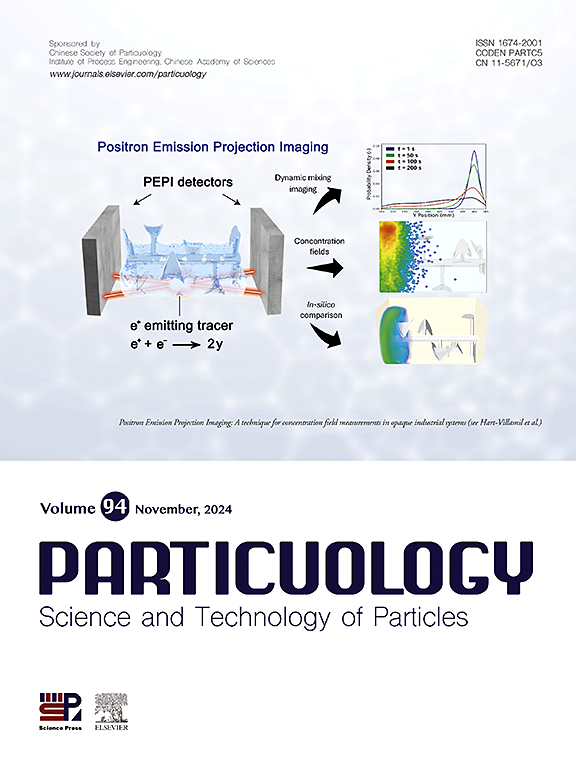Numerical investigations on the deposition characteristics of lunar dust in the human bronchial airways
IF 4.1
2区 材料科学
Q2 ENGINEERING, CHEMICAL
引用次数: 0
Abstract
Although it is widely acknowledged that lunar dust (LD) is toxic to the human health, its deposition characteristics in the bronchial airways remain unknown, which is significantly important to understand its toxicity. Therefore, this study employs computational fluid dynamics and machine learning algorithm methods to address this issue considering the difficulty of conducting the experiments of LD deposition. The major results are: (1) the deposition efficiencies (DE) of micrometer-sized LD in the terminal bronchioles vary significantly depending on the human body posture, with a notable difference of DE up to 29% between standing and lying flat postures; (2) LD deposition in various bronchial regions shows differences under activity intensities, with higher DE in segmental bronchi and terminal bronchioles under intense and lower intensive activities, respectively; (3) In predicting DE of LD, machine learning algorithms outperform fitting functions, achieving higher precision and smaller errors, reducing the root mean square error by approximately 60%–80%. These results indicate that LD deposition characteristics in the bronchial airways under lunar environment are also influenced by the combined factors of particle size, activity intensity, and body posture.

月尘在人体支气管内沉积特性的数值研究
虽然月尘对人体健康的毒性已被广泛认识,但其在支气管气道中的沉积特征尚不清楚,这对了解月尘的毒性具有重要意义。因此,考虑到LD沉积实验的难度,本研究采用计算流体力学和机器学习算法方法来解决这一问题。主要结果如下:(1)微米级LD在终末细支气管的沉积效率(DE)因人体姿势的不同而有显著差异,站立和平躺姿势的DE差异可达29%;(2)不同活动强度下,不同支气管区域的LD沉积存在差异,高强度活动下,节段支气管DE较高,低强度活动下,末端细支气管DE较高;(3)在预测LD DE时,机器学习算法优于拟合函数,实现了更高的精度和更小的误差,将均方根误差降低了约60%-80%。这些结果表明,月球环境下支气管内LD的沉积特征还受到颗粒大小、活动强度和身体姿势等综合因素的影响。
本文章由计算机程序翻译,如有差异,请以英文原文为准。
求助全文
约1分钟内获得全文
求助全文
来源期刊

Particuology
工程技术-材料科学:综合
CiteScore
6.70
自引率
2.90%
发文量
1730
审稿时长
32 days
期刊介绍:
The word ‘particuology’ was coined to parallel the discipline for the science and technology of particles.
Particuology is an interdisciplinary journal that publishes frontier research articles and critical reviews on the discovery, formulation and engineering of particulate materials, processes and systems. It especially welcomes contributions utilising advanced theoretical, modelling and measurement methods to enable the discovery and creation of new particulate materials, and the manufacturing of functional particulate-based products, such as sensors.
Papers are handled by Thematic Editors who oversee contributions from specific subject fields. These fields are classified into: Particle Synthesis and Modification; Particle Characterization and Measurement; Granular Systems and Bulk Solids Technology; Fluidization and Particle-Fluid Systems; Aerosols; and Applications of Particle Technology.
Key topics concerning the creation and processing of particulates include:
-Modelling and simulation of particle formation, collective behaviour of particles and systems for particle production over a broad spectrum of length scales
-Mining of experimental data for particle synthesis and surface properties to facilitate the creation of new materials and processes
-Particle design and preparation including controlled response and sensing functionalities in formation, delivery systems and biological systems, etc.
-Experimental and computational methods for visualization and analysis of particulate system.
These topics are broadly relevant to the production of materials, pharmaceuticals and food, and to the conversion of energy resources to fuels and protection of the environment.
 求助内容:
求助内容: 应助结果提醒方式:
应助结果提醒方式:


